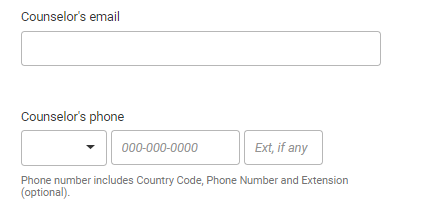A Guide to the Education Section of the Common App

Your GPA and SAT don’t tell the full admissions story
Our chancing engine factors in extracurricular activities, demographics, and other holistic details. We’ll let you know what your chances are at your dream schools — and how to improve your chances!
Calculate your acceptance chancesYour GPA and SAT don’t tell the full admissions story
Our chancing engine factors in extracurricular activities, demographics, and other holistic details. We’ll let you know what your chances are at your dream schools — and how to improve your chances!
Calculate your acceptance chancesThe Education section of the Common App is exactly what it sounds like: it’s where you tell your chosen colleges about your high school academic performance. From grades to class rank to what courses you took, colleges will want to get a detailed look at what–and how–you did in high school.
Four years of academic work creates a great deal of information to convey. As with other sections of the Common App, you’ll only have to actually enter this information once, and it will be copied to all the colleges to which you submit applications. Since basically every college requests the same or similar educational information, this can save you a lot of time and typing.
Before you begin filling out the Education section, you’ll want to gather the necessary data from your records and clarify any requirements that are unclear to you. In this post, we’ll go over the specific questions you’ll be asked and the information you’ll be expected to provide in the Education section of the Common App.
Are you unsure what a “weighted” GPA means? Wondering where and how to tell colleges that you graduated early from high school? Stressing out about listing your academic and career aspirations under the Future Plans section? Read on for more application guidance from CollegeVine on these topics and more.
Is your GPA high enough to get into your dream school? Calculate your admissions chances now.
Accessing the Education Section
First of all, to fill out the Common App’s Education section, you’ll need to get to it. In order to access the Education section of your Common App, you’ll need to log into your Common App, click on the Common App tab, and click on Education in the column on the left side.
The Education section is divided into nine subsections; click on the title of each subsection to open it up. Each part of the Education section will guide you through questions covering different aspects of your educational history, from where you’ve gone to school to how you did in school.
Below, we’ll go through each part of the Education section, from “Current or Most Recent School” to “Future Plans,” with more detailed instructions on how to complete the questions you’ll find there.
The provided screenshots are taken from a sample student Common App profile that we at CollegeVine have set up. Your own Common App profile may look slightly different, depending on what information you’ve already entered.
When you’re finished filling out a section of the Education section, hit the “Continue” button to move along to the next one. You can move directly to other parts of the Education section by clicking the appropriate header.
Current or Most Recent School Section
In this section, the Common App will collect information about the school you currently attend or have most recently attended.
Current or Recent School Lookup
Your first task is to tell the Common App what high school you attend now or most recently attended, as well as various facts about that high school. Fortunately, you don’t have to provide all this information from scratch; the Common App system includes a database of high schools that you’ll search through to find and choose yours.
When you open up the Current or Most Recent School section, you’ll see this:

Click on the Find School link. The box below will pop up:

Now you can search for your high school. On the top of the box you’re given a number of search options; you can search by school name, CEEB code (a number assigned to your school by the College Board), or location. Fill out whichever of these fields works best for you, and you’ll see your results appear below.
Scroll through the list to find your high school and click on the circle in front of its name; then click the “Continue” button to add that school as your current or most recent high school. When you return to your Current or Most Recent School section, you’ll see that your school and its contact information have been added to your Common App. Below, you can see that our sample student has designed Bronx High School of Science as their current or most recent school.
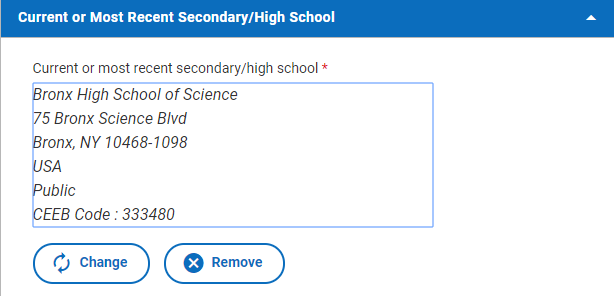
If you made a mistake or need to change what school you’ve designated, simply click “Change” or “Remove” under the school’s information and use the search function again.
If you have been homeschooled and are a member of a larger homeschooling organization, you may be able to find that organization using the search function. If not, or if you were homeschooled outside of any such organization, scroll to the bottom of your search results and choose the option that says “Home schooled.” You’ll be prompted to enter some additional information manually.
What if you can’t find your school using the search screen? First, double-check the information you’ve entered; then, triple-check it. Try typing only the first word or two of your high school’s name and going through the list, or using a different search field than you initially tried.
The search function can be a bit finicky when it comes to searching by school name, so make sure you’re using your high school’s full formal name, not a nickname. For instance, our sample student would need to search for the full name “Bronx High School of Science,” or perhaps just “Bronx” or “Bronx High School.” Even if some people refer to this school simply as “Bronx Science,” searching for that school name will not bring up the correct result.
If you absolutely can’t find your high school in the database, scroll down to the bottom of the list of school results and select “I don’t see my high school on this list.” You’ll then need to enter your school’s information manually.
Other Questions
Once you’ve designated your current or most recent school, you’ll have to answer a list of questions about that school, seen in the following screenshot. Below the screenshot, we’ll go over how to respond to each of those questions.
One more note on completing this section: if you don’t have a school counselor, fill in these answers for whoever has “overseen your academic progress,” as the Common App puts it, and will fill out the School Report section of your Common App. This might be a school principal or another school official, or a parent if you were homeschooled; it depends on your situation. Ask your counselor or school official if you have any questions about how to identify them in this section.
- Date of entry: Choose the month and year that you started attending this school.

- Is this a boarding school?: Do some or all students sleep at your school? If so, answer yes; if not, answer no. If you answer yes, you’ll be asked whether you personally reside at the school; answer yes if you do, no if you don’t.
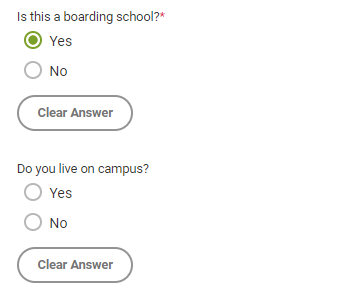
- Did you or will you graduate from this school?: Answer yes if you already graduated from this school or if you plan to graduate from this school. Answer no if you no longer attend this school but didn’t graduate from it, or if you don’t plan to graduate from this school. Once you answer this question, the Common App will ask you to specify the month and year you left or will leave this school.

- Counselor’s prefix: Choose between Dr., Mr., or Ms. in the drop-down menu based upon which prefix your counselor uses in official correspondence.

- Counselor’s first name, counselor’s middle initial, and counselor’s last name: Fill in your counselor’s full first and last names, and check your spelling. If you don’t know your counselor’s middle initial, that’s fine; just leave that field blank.
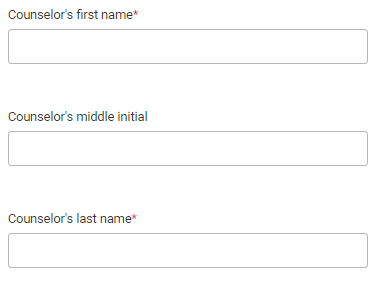
- Counselor’s job title: Fill in your counselor’s formal job title; if your school doesn’t have a counselor, fill in the job title of whichever school official you’re using for this section.

- Counselor’s email and counselor’s phone: Fill in your counselor’s requested contact information. If your counselor is outside the United States, make sure you include the correct country code in their phone number. Also include their phone extension if they have one. Your counselor is an important element of your application, so double-check that you have transcribed this contact information correctly.
Other School Section
In this section, you’ll enter information about any other schools you’ve attended for high school, aside from the one you’re currently attending or most recently attended. For instance, if you moved to a new city during high school, this is where you’ll put information about the school you attended before you moved. If you were homeschooled for part of high school but then attended a traditional school, you’ll list your homeschooling experience as an additional school here.
When you first open up the Other School section, you’ll see the following:

The question reads If you have attended any other schools, please indicate the number of schools. If you have not attended any other high schools, choose 0 from the dropdown menu; you won’t have to answer any other questions in this section.
If you have attended one or more other schools, choose the number of schools you’ve attended, excluding your current or most recent school—the one you talked about in the last section. For instance, if you attended a total of three different high schools including your most recent high school, you would choose 2 in this menu. You can add up to three additional high schools.
If you choose any number other than 0 for this question, you’ll need to add more information about the school(s) you attended. For each additional school, you’ll use the search function to search the Common App database, just as you did for your current or most recent school in the last section. You can refer back to that section for advice on looking up your school(s). If you were homeschooled or can’t find your school, you’ll need to enter its information manually, just as we described in the last section.
Once you’ve chosen a school, your screen should look something like the screenshot below. We’ve indicated that our sample student has attended Los Angeles School of Global Studies.

Notice that for this student, Los Angeles School of Global Studies has been labeled “School 2.” Bronx High School of Science, which our sample student designated as their current school, is School 1. Additional schools that they had attended, if there are any, would be School 3 and School 4.
Below the school information, you’ll need to enter the dates between which you attended that school. Under School 2 from date, enter the month and year you started attending that school. Under School 2 to date, enter the month and year you stopped attending that school. Repeat this process for any additional schools you might have.
College & Universities Section
In this section, you’ll provide information about any colleges or universities you have already attended. This section is relevant to you if you took any courses at a college or university while you were in high school through a “post-secondary option” or similar program. In this context, AP and IB courses do not count as college courses.
When you initially open up the Colleges & Universities section, it will look like this:
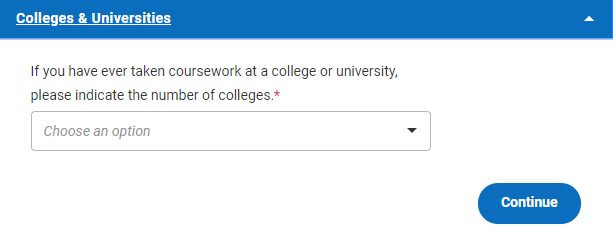
The first question reads as follows: If you have taken a college/university course, please indicate the number of colleges. If you have not taken any college courses in high school, choose “0” in the dropdown menu; there will be no further questions for you in this section.
If you have taken one or more college courses in high school, choose the number of colleges you attended using the drop-down menu, up to three colleges. (Remember, this is the number of colleges you were enrolled at, not the number of courses you took.) This will open up additional questions for you to answer.
Once you indicate that you attended one or more colleges while in high school, you should see the following list of questions for each college. Below the screenshot, we’ll go over the details of how to answer each of these questions.
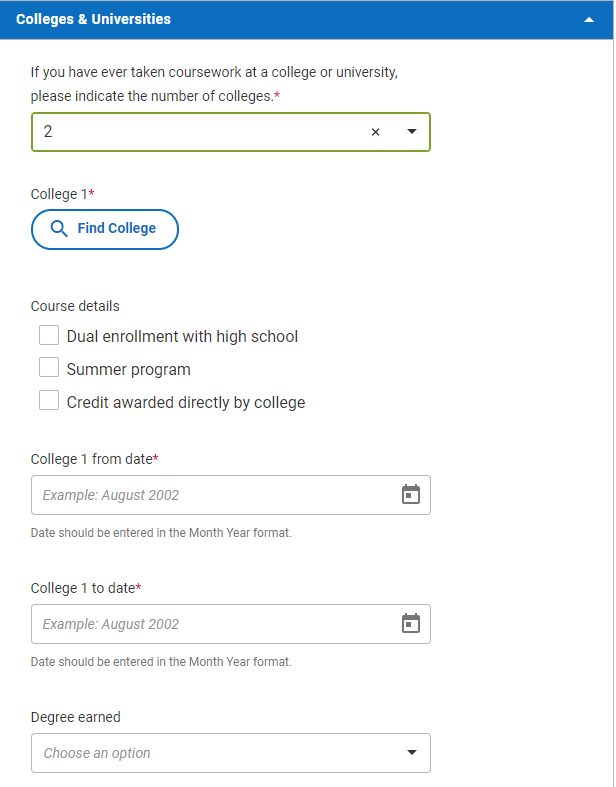
- College 1 lookup: Here, you’ll look up the college you attended in a system very similar to that which you used to look up your high school(s). Our advice above about looking up your high school(s) applies here as well. If you’ve checked and rechecked your search terms and you still can’t find your college, choose “I do not see the college I’m looking for on this list,” and manually enter the college’s information when prompted.
- College 1 from date: Choose the month and year you started attending this college.
- College 1 to date: Choose the month and year you stopped attending this college.
- Degree earned: If you earned a degree from a college while attending high school, choose the degree you earned from a drop-down list. If, like most students, you did not earn a degree from a college while attending high school, you don’t need to answer this question.
You’ll need to repeat these steps for any additional colleges you attended while you were in high school.
Grades Section
In this section, you’ll provide information about your academic performance in high school- specifically, your grades as expressed by your class rank and GPA. When you click on Grades, you’ll see a screen like the one below:
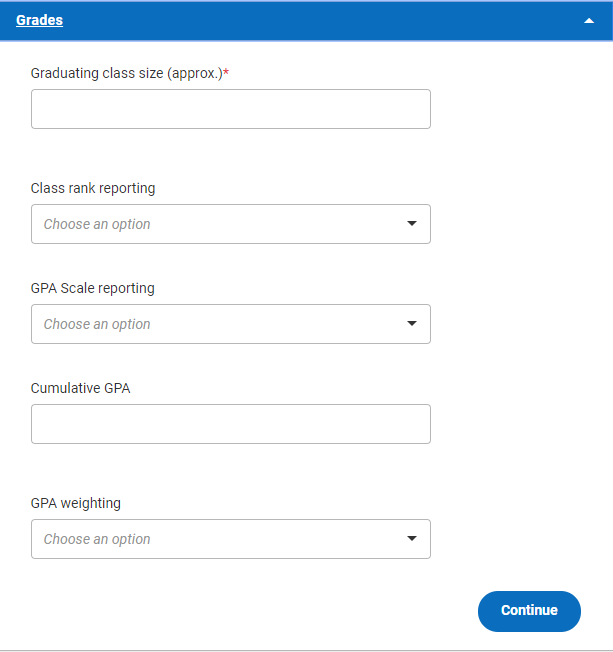
We’ll go over each of the questions you need to answer below. It’s likely that you won’t know all of these answers offhand, but your school should be able to answer them for you. In general, if you don’t know the answer to one of these questions, or if you don’t know what the question means in the context of your high school’s particular policies, you should ask your counselor or equivalent school official.
- Graduating class size: Enter the number of students in your graduating class. Be aware that this number may change from time to time as students’ plans change.
- Class rank reporting: This question covers both how your school ranks students, and what your actual rank is within your class. First, you’ll choose from the initial drop-down menu to indicate whether your high school ranks students exactly or by decile, quintile, or quartile. (Your counselor can explain what this means.) If, as with some high schools, your school has decided not to keep track of class rankings, you’ll choose None. If your school does rank students, you’ll have to answer two additional questions.
- Class rank: If your high school ranks students, you’ll either type in your numerical rank or choose your decile, quintile, or quartile rank from a drop-down menu.
- Rank weighting: If your high school ranks students, you’ll need to choose whether your rank is weighted or unweighted from the drop-down menu. Weighted rank uses weighted GPAs; unweighted rank uses unweighted GPAs. We’ll go over what that means below.
- GPA scale: Choose the number of points in your school’s GPA scale from the drop-down list. This numerical answer might be anywhere from 4 to 100, depending on your school’s grading system.
- Cumulative GPA: Enter your cumulative GPA—that is, your GPA taking into account all the high-school courses you’ve taken—just as it appears in your school’s records. (Your GPA is basically an average of the grades you’ve received on your report cards.)
- GPA weighting: Choose whether your GPA is weighted or unweighted from the drop-down menu. Essentially, a weighted GPA is one in which the number of points awarded for an A grade in the course varies, usually according to how difficult the particular course is. For instance, a high school might use a scale of zero to four for most of its courses, but a scale of zero to five for its honors, AP, or IB courses. If you don’t know your GPA on a 4.0 scale, use our GPA converter to find it.
Be aware that the colleges you’re applying to will have access to your full transcript as well as the information you enter here. They’ll see not only your GPA, but your individual grades, any outliers, and your grade trend across your high-school career. Many colleges will actually recalculate your GPA based on their own criteria, so the information you enter here may not be evaluated exactly as you might think it will be.
How does class rank and GPA affect your chances? Use our admissions calculator to see your chances of admission for free. Sign up now to see your chances.
Current or Most Recent Year Courses Section
This section is where you’ll provide detailed information about the courses you’re currently taking, or, if you are no longer in high school, the courses you took during your most recent year of high school. For most students, this will simply mean entering the classes you’re taking during your senior year. Before you start filling out this section, you’ll probably want to have a copy of your schedule on hand.
First of all, you’ll need to report how many courses you’re taking this academic year. The question reads as follows: Please list all courses you are taking this academic year. If you are not currently enrolled, please list courses from your most recent academic year. How many courses would you like to report?
Choose the number of courses you’re taking or took for the year from the drop-down menu. The number you report here will determine what questions you are prompted to answer next.
Once you’ve provided the number of courses you’re taking, you’ll enter information for each of these courses so that admissions officers can evaluate your academic course load. As an example, here’s a screenshot from our sample student’s Common App profile. Note that the sample student has responded that they are only taking one course this academic year; you’ll almost certainly be taking more than that.
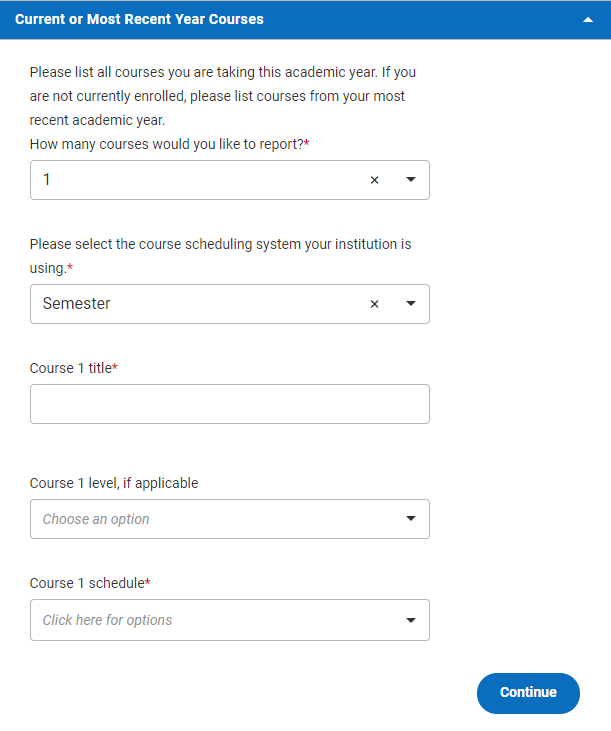
For the question Please select the course scheduling system your institution is using, you’ll be invited to choose between the options of “semester,” “trimester,” and “quarter” in the drop-down menu. This question refers to how the school year is split up at your school—into two, three, or four periods, respectively, for which a new set of grades are added to your transcript. If you’re unsure, ask your counselor which system applies to your school.
Next, you’ll be asked to enter information for each course. Under Course 1 title, type the full name of your first course. (This may be different from what you call the course on an everyday basis—you may refer to “Algebra II and Trigonometry” as simply “Trig,” but colleges will want to see the full course title.)
Under Course 1 level, if applicable, click to choose a designation that applies to your first course, if any. For instance, if your World History course is an honors course in your school’s system, you would click “Honors” here. Ask your teacher or counselor if you’re not sure about a particular course. If your course has none of these designations, don’t click anything for this question.
Under Course 1 schedule, select whichever option from the drop-down menu applies to that particular course. (The options you see here will vary depending on how you answered the question about your school’s course scheduling system.) Again, ask your teacher or counselor if you’re not sure.
You’ll repeat these steps for each of however many courses you indicated you’re taking this year or took in your most recent year. They’ll be listed as Course 2, Course 3, and so on.
Course rigor is an important factor for getting accepted to a top school. See how course rigor affects your chances of admission with CollegeVine’s chancing calculator.
Honors Section
In this section, you’ll list and describe up to five academic honors that you’ve received. Since choosing and detailing those honors can be complicated in and of itself, we at CollegeVine have chosen to write a separate post on this issue. Head over to our post on “Reporting Honors and Awards on the Common App” to learn what you should report in this section and how you should report it, from Honor Roll to summer programs to National Merit scholarships.
Community-Based Organizations Section
In this section, you’ll answer questions about any community-based organizations which may have helped you with the college application process without charging a fee. These organizations might include Questbridge, Upward Bound, the Boys and Girls Club, or others.
If you’ve been aided by a community-based organization like these, you likely know it already. If you’re not sure whether an organization that has helped you qualifies under this section, an employee or leader of that organization may be able to clarify its status for you, or your school counselor may be able to help.
When you open this section, you’ll initially see the following:
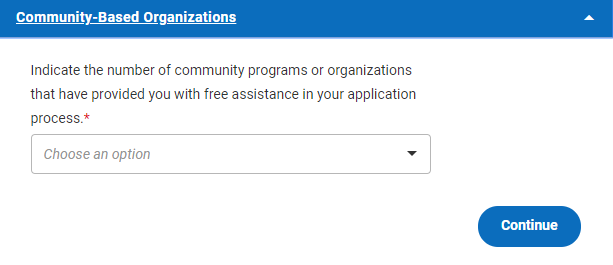
The question reads, Indicate the number of community programs or organizations that have provided you with free assistance in your application process. If no such program or organization has provided you with free assistance in the college application process, you’ll choose 0 from the drop-down menu, and you won’t need to answer any more questions in this section.
If you’ve been provided with free assistance by one or more organizations like this, choose the number of organizations that have assisted you from the drop-down menu. You can enter up to three organizations. You’ll then need to provide additional information about the organization(s) that you worked with.
If you indicate that you have been assisted by one or more community-based organizations, additional questions will appear for you to answer. That screen should look like the screenshot below. After the screenshot, we’ll provide more details on how to answer each of these questions.

Organization 1: Choose the name of the organization that has assisted you from the drop-down list. If your organization is not listed, choose “Other.” (Hint: the list is alphabetical, and “Other” is listed under the organizations that start with O.) If you choose “Other”, an additional field will appear where you’ll type the name of your organization.
The rest of the questions in this section refer to the individual counselor, advisor, or mentor who worked directly with you in this organization. If you’re not sure whose information you should use for this section, ask whoever you have contact with in the organization, and then speak to that person directly to make sure they are comfortable having their information released.
- Counselor/Advisor/Mentor Prefix: Choose Dr., Mr., or Ms. from the drop-down menu based on what prefix your mentor uses in official correspondence.
- First name, middle initial, and last name: Enter your mentor’s full name. If you don’t know their middle initial, that’s okay—just leave that field blank.
- Email and Phone: Enter your mentor’s contact information. If you have multiple phone numbers and/or email addresses for your mentor, ask them which ones they would prefer you to use. If your mentor is outside the United States, make sure you include the correct country code for their phone number.
You’ll answer the same questions for any additional organizations that you’ve indicated have helped you in your application.
Future Plans Section
Finally, we come to the Future Plans section, where you’ll answer two simple questions about your educational and career aspirations. When you open this section, you’ll see the following:
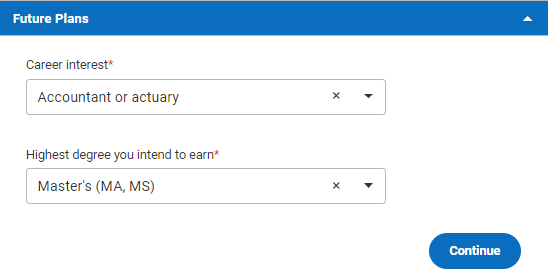
The first question reads Career interest. Here, you’ll choose from a drop-down menu of possible careers. Our sample student has indicated that they’re indicated in becoming an accountant or actuary, but you’ll have many other options. If you don’t see your intended career path in the list, you can either choose the closest available option or choose “Other.” If you haven’t yet decided on a career path, don’t worry- just choose “Undecided.”
The second question reads Highest degree you intend to earn. Here, you’ll choose from a list of possible academic degrees. Our sample student has indicated that they intend to earn a master’s degree, such as an MA or MS. Again, if your intended degree category doesn’t appear in this list, choose “Other,” and if you aren’t sure, choose “Undecided.”
Being asked to specify your future plans so early on in the application process can be a little overwhelming, but you absolutely don’t need to stress out about the questions in this section. Your answers here don’t commit you to anything. Just answer the questions as best you can, and don’t be afraid to choose “Other” or “Undecided” if those answers suit you best.
Concluding the Education Section of the Common App
When you finish the Education section of the Common App, you’re sure to breathe a sigh of relief. You’ve entered a great deal of information, and that information is extremely important to how colleges evaluate your application.
Remember, however, that your Education section doesn’t present a complete portrayal of you as a student and a person. If you’re not totally satisfied with your grades, you still have a chance to wow admissions committees with the other parts of your application, from your activities to your test scores to your essays. You can’t change your grades after the fact, but when you don’t feel like your grades represent you accurately, your full application offers many other opportunities to show yourself in the best possible light.
Be sure to check out some of CollegeVine’s blog posts on other aspects of the Common App, including:
- A User’s Guide to the Common App
- How to Receive a Common App Fee Waiver
- Reporting Honors and Awards in the Common App
- How to Fill Out the Common App Activities Section
- Why Does the Common Application Ask Where my Parents Went to College?
Curious about your chances of acceptance to your dream school? Our free chancing engine takes into account your GPA, test scores, extracurriculars, and other data to predict your odds of acceptance at over 500 colleges across the U.S. We’ll also let you know how you stack up against other applicants and how you can improve your profile. Sign up for your free CollegeVine account today to get started!

